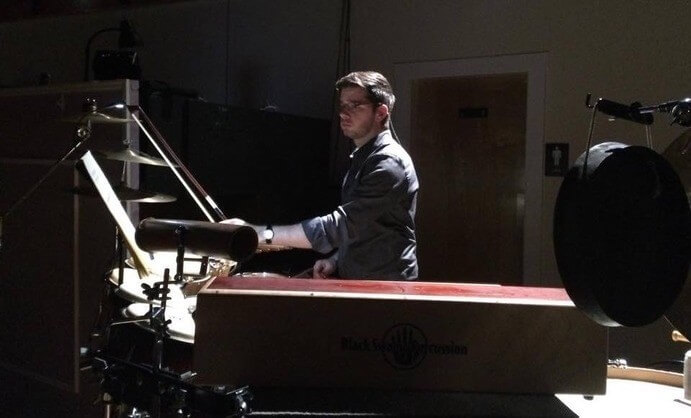Dedicating itself to the performance of recent masterworks in the Western contemporary music canon, Sound Icon continues to be a leader in ambitious programming with unparalleled performances in the Boston area. Their recent performance was no exception to this established reputation. On Friday, January 16, the group abandoned the typical strings, winds, or brass and exchanged it for an elaborate setup of non-pitched percussion (like wood blocks, log drums, various skin drums, gongs, and cymbals) to perform the late-twentieth century masterwork Le Noir de l’Etoile (1989-1990) by Gérard Grisey. It was as much a visual spectacle filling up Instagram feeds as it was an immersively aural experience. The Center for the Arts at the Armory in the cozy up-and-coming bougie Spring Hill neighborhood in Somerville, MA worked well for this piece which requires six percussionists playing in a circle surrounding the audience. Despite being cavernous and antiquated the acoustics in the space are rather dry and non-invasive.
Gérard Grisey’s Le Noir de l’Etoile stands in the middle of the antiphonal percussion canon with Xenakis’s Pléïades (1978) in the front, and Adams’s Inuksuit (2009) as the most recent. What they all share, besides “guys in a giant circle hitting things,” is the use of space as an integral musical element.* Of course live concert music is more than a stereophonic experience, but the way the sound goes over you and through you in an unmediated conversation between the performers is unique to this performance practice. At its heart there is something primal and eternal in these works and each time they are performed there seems to be a certain buzz generated among new music enthusiasts.
Sound Icon – Photo by Victoria Cheah
Instead of his usual job as conductor of the ensemble, Jeffrey Means stepped behind the battery of log drums (in lieu of less resonant wood blocks), toms, and cymbals with five of Boston’s best percussionists including Robert Schulz, Matt Sharrock, Nick Tolle, Aaron Trant, and Mike Williams for the evening’s length concert.
Lacking the linearity of melody and gravitational pull of harmony, the music becomes an experience of subtle, or dramatic, changes in texture and timbre. And with most of Grisey’s music it is this unfolding of various events of texture and timbre that relies wholly on the audience’s perception of time. In the case with Le Noir de l’Etoile what alters this experience of time is Grisey’s close attention to space. The audience sits in concentric circles facing the middle of the space while the performers play at the edge. This means that the idea of the audience viewing the performers is obfuscated because you can only see a few of the performers. This then forces the audience to listen and Grisey (much like many other antiphonal percussion pieces, say Xenakis’s 1978 work Pléïades, for example) uses the perception of space as another layer of musical expression.
Composer Gérard Grisey
The percussionists (aided by click tracks sent through earbuds) executed this phenomenon of similar gestures being passed through space. We heard a whirling of snares being passed as a continuous gestural loop throughout the space as if we were caught inside the energy fields of the Vela pulsar itself. The snare loop would then subtly, or dramatically, shift to loops of wood blocks. Sound Icon’s expressively nuanced and technically masterful performance exposed the paradoxically synchronous and disjunct beauty of textural and timbral shifts that make the pulsar field recordings that show up in the middle of the work sound uncannily synthetic which magnifies their natural aural beauty.
The audience was pulled out of this meandering blur with the return of the textural and colorful loops that are even more striking and violent than earlier iterations. Yet, in a seemingly inappropriate break of character, Bob Schulz ended the piece with a spectacular striking of a large dangling crotale that dazzled the piece to a dramatic end. The audience was left in a moment of wonder and laughter. It was as if the immersive experience of the awe-inspiring heavens was sent crashing to our own ridiculous existence. One that is rife with mere humans trying to impersonate the heavens through guys hitting things with sticks. The primal and the eternal. Sound Icon’s imitation of the heavens in Le Noir de l’Etoile as the only piece of the concert was an excellent and restrained choice of programming. Their flawless execution and emotional projection matched the ambitiousness of Grisey’s work and in its fifth season shows that they aren’t getting too cozy, but rather are continuing to challenge their audience through the high stakes of virtuosic performing.
—
*It should be noted that Grisey intended the piece to also be time specific in his notes. It was originally intended to coincide with live radio broadcasting of the Vela and 0329+54 pulsars (whose periodic rhythms are used throughout the work) that would be piped into the performance space. Links courtesy of Matthew Guerrieri.

